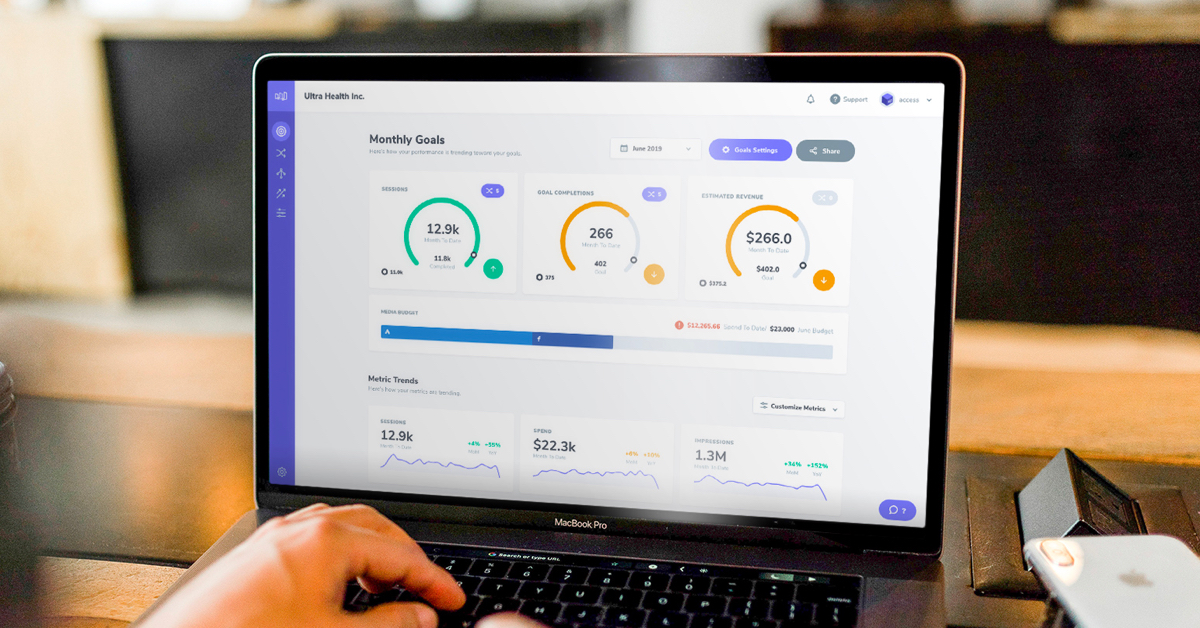
Wouldn’t it be nice to cut down advertising costs while still seeing a greater ROI?
Well, it’s possible.
You simply have to know how to optimize ad spend properly within your PPC campaigns.
In fact, the average CPC for Facebook ads is $1.86. How does yours stack up against that number?
If it’s much higher, don’t worry.
Keep reading and you’ll learn how to quickly and easily reduce ad spend.
Start Defending Against Marketing Failures Today!
Discover why over a 1000 businesses trust Hawke AI to help protect their marketing ROI.
Request a free trialDouble down on keywords that drive the most results
Have you heard of Pareto’s principle?
It’s a philosophy that states 80% of the results we get come from 20% of our actions. We see this all of the time in marketing.
You may find that a couple of strategies, ads, or audiences deliver most of the results for your company. This creates an opportunity similar to split testing where you can double down on your winners.
In our case, we’re talking about keywords.
They are the foundation of successful Google Ads campaigns, so you need to spend time studying which search terms are worth your money and which aren’t.
It’s not uncommon for businesses to spend thousands of dollars or more before they realize some keywords aren’t doing anything productive.
Let’s avoid that.
You can see how all of the keywords in any given Google Ads campaign are performing by first selecting the campaign from your dashboard overview.
Click the “Keywords” tab with the campaign selected to view all of the chosen search terms and their performance metrics.
Pay attention to:
- Which keywords are receiving the most amount of impressions, clicks, and which aren’t.
- The search terms which are converting the most and have the best cost per conversion.
- Which keywords are making up the majority of your ad spend.
- Any search terms that are receiving a lot of impressions and clicks but not converting users.
With this information, you want to remove keywords that are receiving impressions and attracting clicks but not converting. Also note that you need to optimize the landing page, which you’ll learn about later, as the keyword may not be the issue.
Furthermore, you want to refocus campaigns on the few keywords that are generating most of the conversions.
By removing the poor performing search terms, you will save on ad spend which you can put back into the keywords that are delivering results.
Ultimately you want to find a balance within your campaigns where you have keywords that align with your budget, convert well, and have a fair cost per conversion relative to your average customer value.
Filter out losers with negative keywords
Negative keywords are search terms that you do not want your ads to display under. For example, if you added “New York” as a negative keyword, your advertisement wouldn’t be shown for any term with “New York” in it.
You can use negative keywords strategically to avoid displaying ads to lower quality audiences since every search term has a different intent.
Similar to what we spoke about previously on doubling down on good performing keywords, negative keywords allow you to filter out the losers and focus on the winners.
Add negative keywords to an existing Google Ads campaign by clicking “Negative Keywords” via the top navigation on the dashboard.
Click the blue plus button on the following page to begin adding negative keywords.
Select the correct campaign or ad group, then enter any keywords you wish to not be displayed for in the text box.
Click the save button once you’re satisfied.
Additionally we recommend analyzing the “Searches” results of your campaign. Here you will find exactly what users are querying to find your ads. You may notice that there are irrelevant terms which you can then filter out thanks to negative keywords.
Optimize which devices you deliver ads to
Mobile devices are quickly becoming the go-to channel for consumers to shop and browse the internet. This is why it’s important to analyze which devices your audience uses the most, and which are responding the best to your ads.
No audience is the same, either. You may find that a majority of your customers respond best to mobile optimized ads or desktop variants, for example.
Navigate to the “Devices” section of Google Ads to see what devices are making up the majority of your campaign performance.
Analyze the campaign results to determine:
- What device has the highest conversion rate, impressions, and click-throughs. You can refocus a campaign to strictly target the device delivering the most results.
- Which devices aren’t converting well or taking up too much ad spend. These you can remove from campaigns or decrease how much budget is put towards them.
Optimize when you deliver ads
Just like certain devices, keywords, and creatives can outperform others by a landslide, the time you deliver ads can make a huge difference in conversion and ad spend, as well.
While this depends on the exact industry you’re, product being sold, and target audience, we do know some things in general about PPC timing. For example, Monday tends to be the highest grossing day for retailers, with Saturday and Sunday being the lowest.
If you’re a retail company running pay per click ads, you could increase ad spend on Monday and lower it on the weekend going off of this data.
However, nothing beats creating your own strategy.
That’s why we recommend you visit your Google Ads(or other ad dashboard) and go to the “Ad schedule” section. Select the “Day & Hour” dashboard afterwards to see the exact day and times and how your campaign is performing during them.
You will most likely discover that certain days and hours have higher conversion rates, lower cost per conversion, and increased performance over others.
Manually adjust when your ads appear by going back to the ad schedule page and clicking “Edit ad schedule.”
Select the campaign you’d like to edit, and add individual days or groups from the dropdown menu. Click the start and end time options to select which hours to run the campaign.
Hit the save button once you’re satisfied, and enjoy watching a bump in campaign performance.
Manually reduce bidding prices
Spending too much on ads? While there are many different techniques to reduce ad spend as we’ve covered so far, sometimes the simplest approach is the best.
Whether you’re using Google Ads, Facebook, Pinterest, or another platform, they all have the option to manually reduce bidding prices.
While this can have a detrimental effect on how many people will view your ads, it can help with budgeting and reducing costs until you optimize campaigns.
Once you’ve executed the other techniques we’ve outlined today and have a winning campaign, more budget can be dedicated towards it.
Refine your buyers persona
A buyers persona is a personification of your ideal customer. This includes elements like their demographics, problems, and questions.
Understanding customers deeply allows you to tailor ads to their exact situation. Everything from images to sales copy can be refined for this specific group of people.
Improving your targeting through the use of a buyers persona will increase conversion rates since you’re speaking to hyper-relevant users. Furthermore, it can help you lower ad costs by weeding out audiences that don’t engage well with your campaigns.
You can begin improving your buyers persona with a free tool like Google Analytics. If you don’t already have it installed, complete the following steps:
- Create a free Google Analytics account.
- Create a new property from the admin dashboard.
- Connect the account to your website via a plugin or app.
Once you have done this, navigate to the “Audience” tab from the left sidebar.
Here you can analyze different aspects of the users visiting your website, such as demographics, interests, location, and more.
You can save or export any data of interest from the top right of the page.
All of these metrics can be used to make the most accurate possible buyers persona to improve PPC targeting. Alternatively you can export the Google Analytics data directly into other platforms as a CSV file.
Wrapping up
Driving traffic through paid ads remains as one of the most effective channels to generate revenue. However, if you don’t tinker with the right settings you will spend more money than needed.
You can start reducing ad spend by finding which keywords, audiences, devices, and hours generate the best results for your campaigns. You can then run ads more optimally by removing search terms and other elements that cost too much.
This is also where negative keywords come in very handy. Google Ads displays all of the search terms users are clicking when your ads are displayed, and you can manually block irrelevant and poor performing ones.
Lastly, don’t forget to keep things simple. You can reduce ad spend instantly by opting to reduce bidding prices or budget until you find winning combinations.
Morphio can help your company make better decisions and find new opportunities within PPC campaigns. Learn how we can help today.
